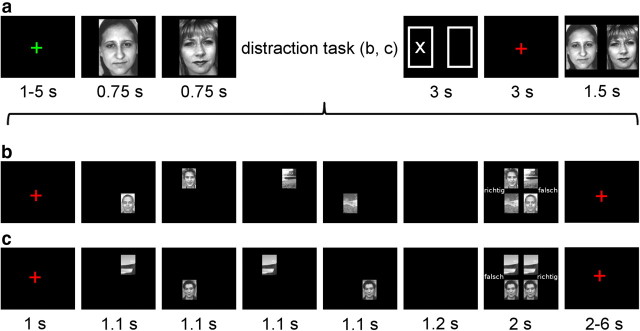Figure 1.
Experimental paradigm. a–c, The task involved a memory task (a) with a nested distraction task (b, c). Subjects encoded either two faces or two scenes (a; here only the face condition is shown). There was a blank screen for 50 ms between the encoding stimuli. Immediately after encoding, in 50% of all trials, subjects performed a distraction task (b) during which they had to memorize the identity and position of two faces and two scenes shown briefly in four quadrants of the screen with 200 ms of blank screen between individual distraction stimuli. These were then shown together and participants had to decide whether the same pictures reappeared in the same positions (“richtig,” correct) or whether one picture had switched position or was replaced by another stimulus (“falsch,” incorrect). The no-distraction task (c) was performed in the remaining 50% of all trials and was identical to the distraction task with the exception that two identical faces and two identical scenes were shown. Additionally, the no-distraction task was always correct and therefore placed minimal demands on working memory. The response assignment for correct and incorrect was randomized between left and right buttons across trials for both distraction and no-distraction tasks. Following the distraction or no-distraction task, a cue was shown (a) indicating whether the first or second item from the memory set was to be retrieved (3 s). Then a fixation cross appeared (3 s), after which the two items from the memory set were presented together (position randomized) and subjects indicated the cued item via button press.

